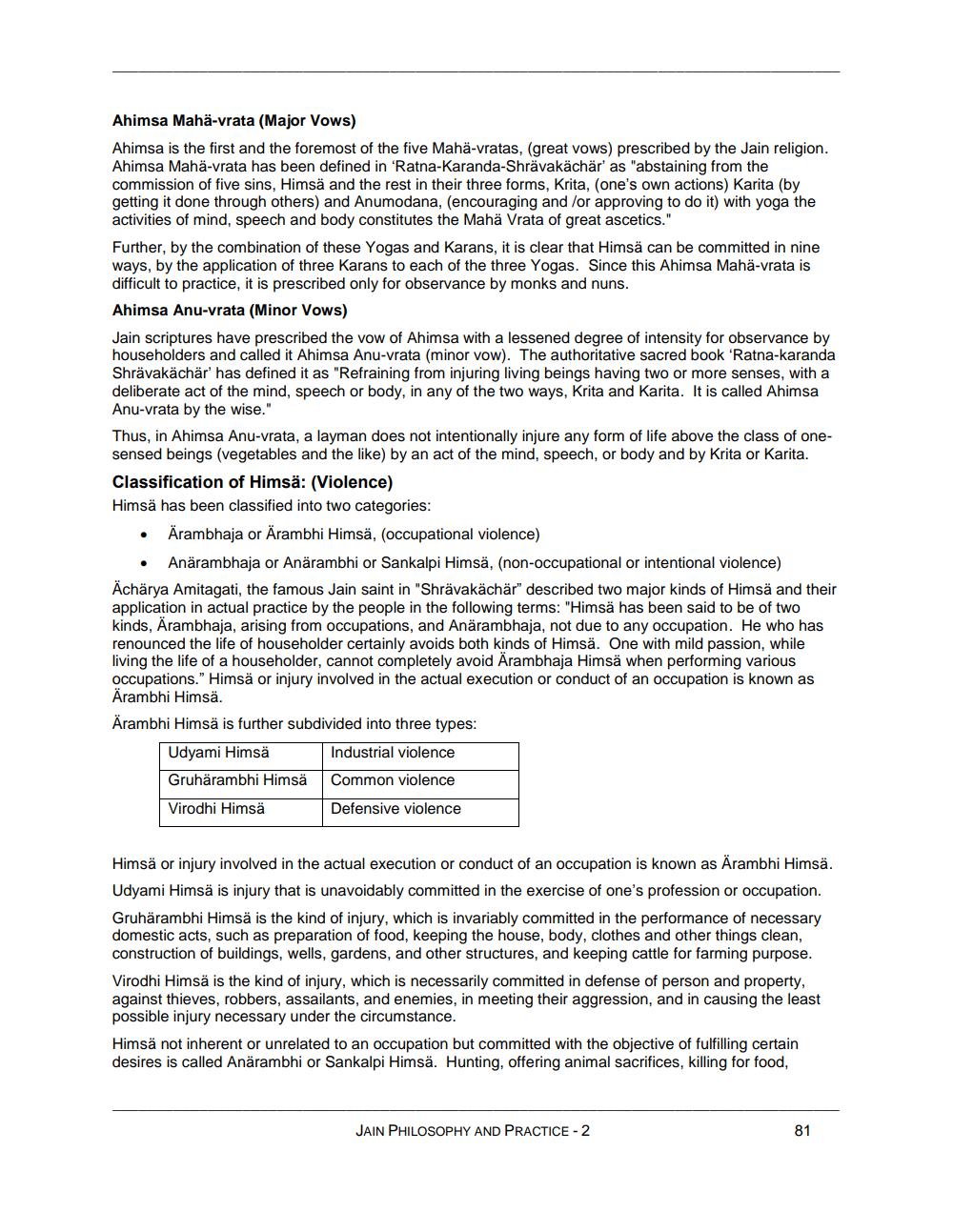________________
Ahimsa Mahä-vrata (Major Vows)
Ahimsa is the first and the foremost of the five Mahä-vratas, (great vows) prescribed by the Jain religion. Ahimsa Mahä-vrata has been defined in 'Ratna-Karanda-Shrävakächär' as "abstaining from the commission of five sins, Himsä and the rest in their three forms, Krita, (one's own actions) Karita (by getting it done through others) and Anumodana, (encouraging and /or approving to do it) with yoga the activities of mind, speech and body constitutes the Mahä Vrata of great ascetics."
Further, by the combination of these Yogas and Karans, it is clear that Himsä can be committed in nine ways, by the application of three Karans to each of the three Yogas. Since this Ahimsa Mahä-vrata is difficult to practice, it is prescribed only for observance by monks and nuns.
Ahimsa Anu-vrata (Minor Vows)
Jain scriptures have prescribed the vow of Ahimsa with a lessened degree of intensity for observance by householders and called it Ahimsa Anu-vrata (minor vow). The authoritative sacred book 'Ratna-karanda Shrävakächär' has defined it as "Refraining from injuring living beings having two or more senses, with a deliberate act of the mind, speech or body, in any of the two ways, Krita and Karita. It is called Ahimsa Anu-vrata by the wise."
Thus, in Ahimsa Anu-vrata, a layman does not intentionally injure any form of life above the class of onesensed beings (vegetables and the like) by an act of the mind, speech, or body and by Krita or Karita. Classification of Himsä: (Violence)
Himsä has been classified into two categories:
• Ärambhaja or Ärambhi Himsä, (occupational violence)
• Anärambhaja or Anärambhi or Sankalpi Himsä, (non-occupational or intentional violence) Ächärya Amitagati, the famous Jain saint in "Shrävakächär" described two major kinds of Himsä and their application in actual practice by the people in the following terms: "Himsä has been said to be of two kinds, Ärambhaja, arising from occupations, and Anärambhaja, not due to any occupation. He who has renounced the life of householder certainly avoids both kinds of Himsä. One with mild passion, while living the life of a householder, cannot completely avoid Ärambhaja Himsä when performing various occupations." Himsä or injury involved in the actual execution or conduct of an occupation is known as Ärambhi Himsä.
Ärambhi Himsä is further subdivided into three types:
Industrial violence
Udyami Himsä Gruhärambhi Himsä Virodhi Himsä
Common violence
Defensive violence
Himsä or injury involved in the actual execution or conduct of an occupation is known as Ärambhi Himsä. Udyami Himsä is injury that is unavoidably committed in the exercise of one's profession or occupation. Gruhärambhi Himsä is the kind of injury, which is invariably committed in the performance of necessary domestic acts, such as preparation of food, keeping the house, body, clothes and other things clean, construction of buildings, wells, gardens, and other structures, and keeping cattle for farming purpose. Virodhi Himsä is the kind of injury, which is necessarily committed in defense of person and property, against thieves, robbers, assailants, and enemies, in meeting their aggression, and in causing the least possible injury necessary under the circumstance.
Himsä not inherent or unrelated to an occupation but committed with the objective of fulfilling certain desires is called Anärambhi or Sankalpi Himsä. Hunting, offering animal sacrifices, killing for food,
JAIN PHILOSOPHY AND PRACTICE - 2
81




